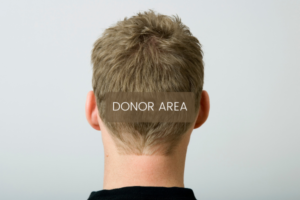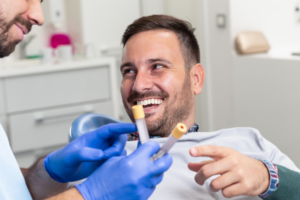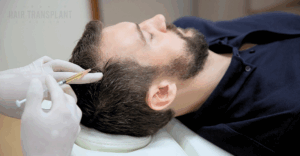While the rules are not written in stone, reputable hair transplant surgeons generally agree that it’s probably not a good idea to have a hair transplant under age 25.
Why?
At least 20% of men will have some degree of hair loss starting in their 20s. Significant hair loss early in life isn’t very common, but when it occurs it can be worrisome, embarrassing and result in loss of confidence and social withdrawal. So why can’t a male have a hair transplant that early in life?
The reason has to do with your donor supply.
In a hair transplant, permanent hair from your donor area at the back and sides of your head is moved, or transplanted, to areas of your head where you have hair loss. Unfortunately, humans don’t have an unlimited supply of donor hair. Once that hair is moved from the donor area to the thinning area, it doesn’t grow back again.
Think of your head as a forest. One part of the forest is sparse with only a few thin trees. That’s your area of hair loss. The other part of the forest is dense and lush, full of thick trees. That’s your donor area. You can move some trees from the thick forest to the thin one to improve the density of the thin forest, but once you move that tree, it’s gone from the thick forest forever, and will never grow back there.
Most men with good donor areas may have anywhere from 3,000 to 8,000 follicles available in their whole lifetime to move from their donor area to their thinning areas. Once those follicles are moved, that’s it. The donor supply has run out, and no more transplantation can be done.
Why Not?!
The problem with considering a hair transplant before about age 25 is that no one can predict the future course of your hair loss. You may just lose a little more, in which case you’ll have plenty of donor hair available. But you may lose a lot more in the following twenty, thirty or forty years. In fact, you may lose much more hair than your donor supply would be able refill. In that case, using up some of your precious donor supply in your early 20s could lead to unfixable hair loss in the future, resulting in a very unnatural appearance later in life. If we were able to predict how much hair you might lose in the future, then there would be no problem. Unfortunately, there’s no way to predict this, even if everyone else in your family has a full head of hair.
Imagine this scenario: A young man in his 20s wants to fix his badly receding hairline and chooses to undergo a 1,500-graft hair transplant. It looks great for a few years, but then he loses even more hair, and now he needs another 2,000-graft transplant to fill in the area behind his hairline. By his mid-20s, he’s used up 3,500 of his available donor follicles. Now his crown is starting to thin out, and a few years later he needs another 2,000-graft hair transplant to fix that. Now he’s used up 5,500 of his available donor follicles, and the thinning of his crown is creeping into his donor area, further diminishing his supply. He may only have a few more donor follicles left if any, but he continues to lose even more hair. Now what?
A good hair transplant surgeon would never allow that to happen. A good hair transplant surgeon isn’t just concerned about what you look like today but is also concerned about helping you look your best in ten, twenty, and fifty years from now. A good hair transplant surgeon will help you achieve a natural-looking head of hair for the rest of your life.
So, what can you do if you’re a young man suffering from early hair loss?

- Speak directly with a reputable, experienced hair transplant surgeon. Avoid “patient consultants” or other non-medical personnel. A good surgeon will take the time to review both your non-surgical and surgical options, and help you develop a long term plan to keep as much of your own hair as possible, ensuring a natural look for decades to come. If your surgeon doesn’t talk to you about ways to help you keep the hair you still have, find a new surgeon.
- Begin with evidence-based, non-surgical strategies that the scientific literature says will help you keep the hair you have. Some of these may even be able to help you regrow some of your own hair. Avoid unproven, gimmicky “therapies” like vitamins, supplements, and oils. Evidence-based treatments include:
- Finasteride. This is a DHT-blocking medication that works well to help you keep your hair. Discuss the pros and cons with your doctor.
- Minoxidil. This is another treatment that works well to help you keep your hair and is available over the counter.
- Low-level laser therapy. There are a lot of bad laser devices on the market, but a few very good ones that keep your hair in a growing phase for a longer period of time and lessen hair loss. We recommend and carry the BIOLIGHT laser cap.
- Platelet Rich Plasma (PRP). You can learn more about how PRP can help with hair loss here. PRP is especially suited to those who are in the early years of their hair loss.
Better yet, consider using a combination of the above strategies. If you have early hair loss, it may be that you must be equally aggressive in fighting it off since you have so many more years of hair loss ahead of you. Each of the above treatments works a little differently, and each of them can work synergistically with the others to give you an even better chance of keeping your hair. Think of it like keeping your front lawn green. Watering it might work, but you’ll get even better results if you also fertilize and weed it.
- Conceal your hair loss in the meantime with topical hair fibres. We carry Instant Hair here at THTS. Hair fibres are a great option for hiding your thinning areas and socializing with confidence, and a great alternative to always having to wear a hat. They won’t come out in the wind or light rain, and they definitely won’t make your hair loss worse.
- Document your hair loss. Take pictures of your head to see where you’re at today. Start on the treatments above, and then take more pictures every 6 months under the same lighting conditions as before to see if what you’re doing is working. If not, try adding something else.
Once your hair loss has stopped or slowed, you may be ready for a hair transplant. You’ll know that you’ll have enough donor supply to correct what’s missing without worrying about losing so much more hair that you’ll run out of donor follicles. Consult with a reputable hair transplant surgeon about the best transplant option for you.









